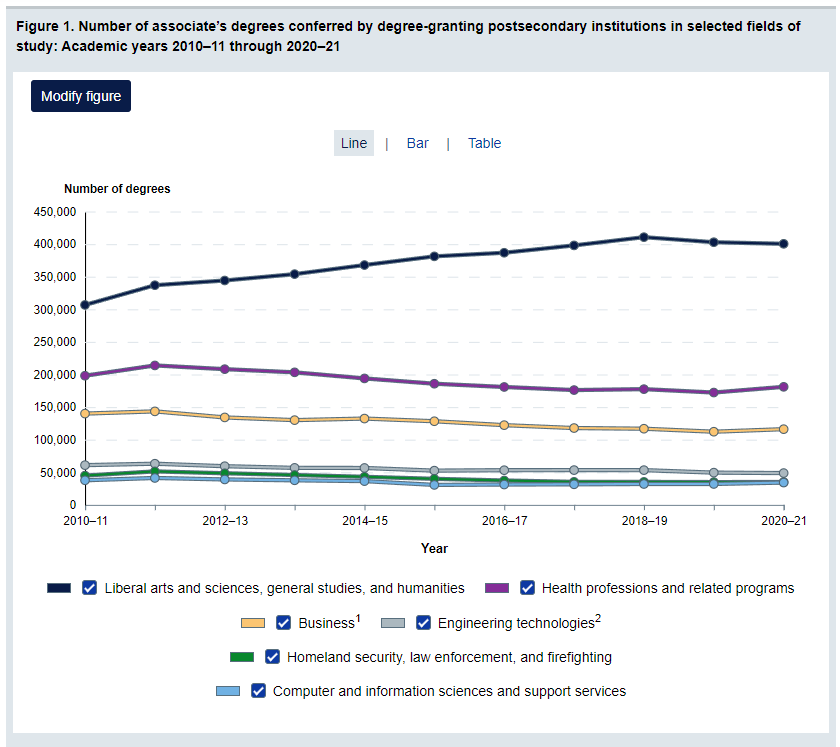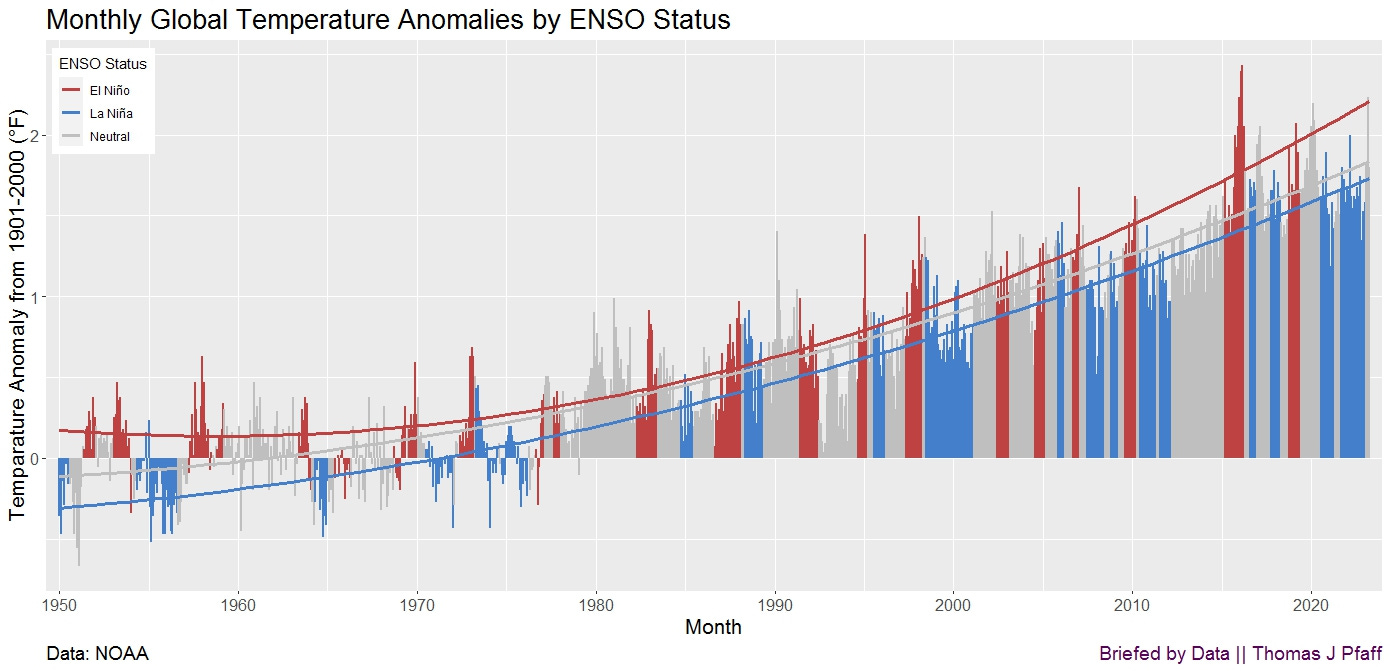Quick Takes and Random Stuff Oct 12, 2023
Male employment, rural upbringing, AI, rocks, and more
What happened to men?
I’ve done a summary of the gender ratio in higher education for undergraduate degrees, master’s degrees, and PhD. In the first two cases, women became a majority in the early 1980's, and the last was in 2006. The percentage of women in these three cases is now 58.5%, 61.8%, and 56%, respectively. So, what are men doing if they are not going to college? I don’t know exactly, but for one, it seems they aren’t working as much. The graph here is from FRED and is simply the ratio of working to total population for everyone, men, and women, in the 25–54 age group. What you see is a downward trend where, in particular, men don’t seem to fully recover from recessions. This graph ends in February 2022 for men (I don’t know why), and at that point they had not recovered from COVID and had not recovered from the 2008 recession. Female employment has steadily increased, and they have recovered from recessions. One explanation here is that recessions tend to hit non-college-educated employment harder, and if men are increasingly in this group, then they end up being more likely to be unemployed.
Where are all the liberal arts students?
Here are two graphs from NCES Fast Facts. The first one is the top six associate’s degrees, and the second is the top six bachelor’s degrees. What is interesting here is that the top 6 degrees for associate’s degrees, by far, are liberal arts and sciences, general studies, and humanities, yet when we look at bachelor’s degrees, this isn’t even in the top 6, where the most popular degree is, also by far, business. Health professions and related programs occupy the second spot in both cases. I’m not sure what to make of this, but if I were running a four-year college, I’d be concerned that the market is telling me that a four-year liberal arts degree has limited value. I’d also be thinking about how to get these associate degrees in liberal arts to move onto my four-year college. Consider this a free tip for college presidents (one should assume that they already know this?).
Maybe the Dems aren’t so smart
If you just graph the overall favorability rating from the Gallop article Neither Party Well-Liked, but GOP Holds Advantage on Issues (10/3/2023), you get the graph below. The Democrats have the reputation of being the party of the educated elite that thinks it is super smart. Anyone who would vote for Trump is deplorable, stupid, or needs reprogramming. For a bunch of folks who think of themselves as smart and educated, they sure don’t seem to be getting that their messaging isn’t working well.
Yes, El Niño will set record temperatures
It is easy to run into articles about El Niño and record temperatures written as if this is some sort of surprise. Here is the main graph from my post, The Three Trends of Climate Change (6/8/2023). The red curve is for El Niño months. Anomalies are clearly rising faster in El Niño months. So, back in June, if you said El Niño was coming, the easy prediction is that we will set temperature records, and when El Niño stops, we won’t set records until it is back again. Now, this is just simple curve-fitting modeling of a time series. If the underlying dynamics change, then these predictions become less reliable, but the dynamics are basically CO2 emissions, and that doesn’t look to change anytime soon. I’ll also make another prediction. A couple of years after this El Niño ends, we’ll start hearing about how climate change has stopped from the right. Rinse, repeat.
The rural two-parent advantage
Most of the article Family, community, and the rural social mobility advantage (Oct. 2023) is behind a paywall, but get enough of a preview with some interesting information. From the abstract:
Children born into poverty in rural America achieve higher average income levels as adults than their urban peers. As economic opportunity tends to be more abundant in cities, this "rural advantage" in income mobility seems paradoxical.
We show that the high level of rural income mobility is principally driven by boys of rural-origin, who are more likely than their urban peers to grow up in communities with a predominance of two-parent households. The rural advantage is most pronounced among Whites and Hispanics, as well as those who were raised in the middle of the country. However, these dynamics are more nuanced for girls. In fact, girls from lower-income rural households exhibit a disadvantage in their personal income attainment, partly due to the persistence of traditional gender norms. These findings underscore the importance of communities with strong household and community supports in facilitating later-life income mobility, particularly for boys. They also challenge the emerging consensus that attributes the rural income mobility advantage to migration from poorer rural areas to wealthier towns and cities.
I think there is a lot of evidence that stable two-parent households are a real plus for children. What I find interesting here is the tension between a more traditional family structure, apparently a plus for boys in poverty, and the traditional gender norms, which may end up canceling out the positive family structure for girls.
The frustration here is that the left will focus only on the gender norms that harm girls, which the right will deny, and the right will focus on the more conservative family structure that is positive for boys, which the left will deny. Yet, it would seem that if the gender norms were relaxed, the family structure would be positive for girls too.
The cost of AI
In The growing energy footprint of artificial intelligence (10/10/2023), we learn
SemiAnalysis estimated that implementing AI similar to ChatGPT in each Google search would require 512,821 of NVIDIA’s A100 HGX servers, totaling 4,102,568 GPUs. At a power demand of 6.5 kW per server, this would translate into a daily electricity consumption of 80 GWh and an annual consumption of 29.2 TWh. New Street Research independently arrived at similar estimates, suggesting that Google would need approximately 400,000 servers, which would lead to a daily consumption of 62.4 GWh and an annual consumption of 22.8 TWh. With Google currently processing up to 9 billion searches daily, these scenarios would average to an energy consumption of 6.9–8.9 Wh per request. This estimate aligns with Hugging Face’s BLOOM model, which consumed 914 kWh of electricity for 230,768 requests, averaging to 3.96 Wh per request.
Note that 22.8 TWh is more electricity consumption than in many small countries. Here is their graph of the energy used per type of search. An AI-powered world is going to use more electricity. Keep building those wind turbines and solar panels.
Rocks are causing climate change
No, I’m not serious, but if you see people blaming rocks, I warned you first. From the abstract of the paper Rock organic carbon oxidation CO2 release offsets silicate weathering sink (10/4/2023):
However, weathering can also release CO2 as rock organic carbon (OCpetro) is oxidized at the near surface6,7; this important geological CO2 flux has remained poorly constrained3,8. We use the trace element rhenium in combination with a spatial extrapolation model to quantify this flux across global river catchments3,9. We find a CO2 release of 68+18−668−6+18 megatons of carbon annually from weathering of OCpetro in near-surface rocks, rivalling or even exceeding the CO2 drawdown by silicate weathering at the global scale10. Hotspots of CO2 release are found in mountain ranges with high uplift rates exposing fine-grained sedimentary rock, such as the eastern Himalayas, the Rocky Mountains and the Andes. Our results demonstrate that OCpetro is far from inert and causes weathering in regions to be net sources or sinks of CO2. This raises questions, not yet fully studied, as to how erosion and weathering drive the long-term carbon cycle and contribute to the fine balance of carbon fluxes between the atmosphere, biosphere and lithosphere2,11.
Here is a key graph (they do provide a link to the data) in the article where locations in the shaded area are a source of CO2 from OCpetro (“The OCpetro represents carbon stored in rocks that has accumulated over millions of years, previously sequestered from the atmosphere by photosynthesis and buried in sedimentary basins”). Note that MtC is megatonnes of carbon.

To me, this is interesting science and an example of how the science community is fine-tuning its understanding of carbon cycles.
The spinning CD
Vera Bloom: Eyes on You
Please share and like
Please help me find readers by forwarding this article to your friends (and even those who aren't your friends), sharing this post on social media, and clicking like. If you're on Twitter, you can find me at BriefedByData. If you have any article ideas, feedback, or other views, please email me at briefedbydata@substack.com.
Thank you
In a crowded media market, it's hard to get people to read your work. I have a long way to go, and I want to say thank you to everyone who has helped me find and attract subscribers.
Disagreeing and using comments
I'd rather know the truth and understand the world than always be right. I'm not writing to upset or antagonize anyone on purpose, though I guess that could happen. I welcome dissent and disagreement in the comments. We all should be forced to articulate our viewpoints and change our minds when we need to, but we should also know that we can respectfully disagree and move on. So, if you think something said is wrong or misrepresented, then please share your viewpoint in the comments.










